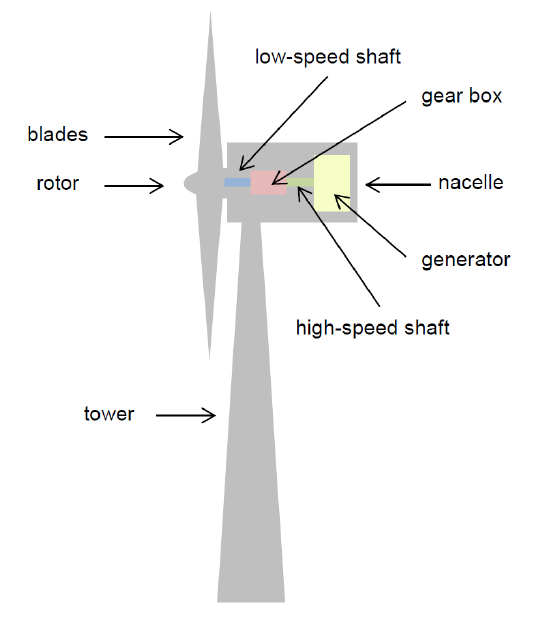Wind turbines operate on a simple principle: they capture the kinetic energy in the wind and convert it into electricity.
The wind direction determines the design of the turbine. Upwind turbines face into the wind while downwind turbines face away from the wind. The wind turbine tower is often made from steel or concrete. Generally, taller towers enable turbines to capture more kinetic wind energy because wind speed increases with height.
Turbines commonly have either two or three blades mounted on a rotor that sit horizontal to the ground. The turbine blades lift and rotate when the wind blows over them.
The blades turn a low-speed shaft at about 30-60 rotations per minute (rpm). A gear box connects the low-speed shaft to the high-speed shaft and increases the rotational speeds from about 30-60 rpm to about 1,000-1,800 rpm. 1,000-1,800 rpm is the rotational speed required by most generators to produce electricity. The high-speed shaft drives the generator which produces AC electrical current. Power cables transport the electricity to ground level.
An anemometer measures the wind speed and transmits wind speed data to the controller. The controller starts the wind turbine at speeds of about 12 to 25 km/h. The controller shuts off the wind turbine at about 90 km/h to protect the turbines from damaging winds. Brakes (which can be mechanical, electrical or hydraulic) can be used to stop the rotor in emergencies.
A wind vane measures the wind direction and communicates with the yaw drive to orient the turbine properly with respect to the wind. A yaw drive, powered by a yaw motor, orients upwind turbines to keep them facing the wind when the direction changes. A yaw drive is not needed in downwind turbines as the wind automatically blows the rotor away from it.
A pitch system turns blades out of the wind to control rotor speed and to keep the rotor from turning in winds that are too low or too high to produce electricity. All the equipment other than the blades and the tower is usually contained within a ‘nacelle’ which is a large box that sits behind the blades.

Diagram of wind turbine.
For more information or discussion, please contact HopgoodGanim Lawyers' Resources and Energy team.